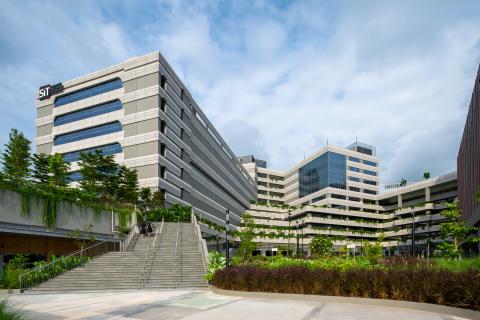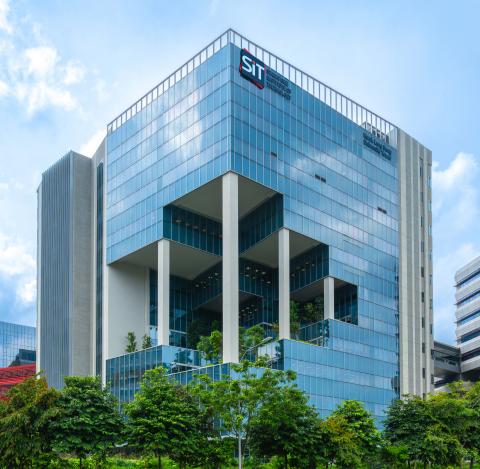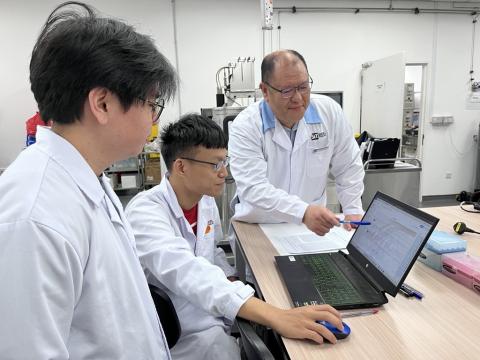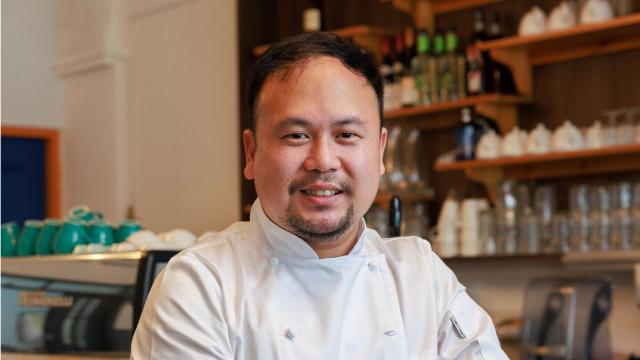With a wealth of expertise in fire safety regulations and incident command of major operations, Principal Professional Officer (PPO) Christopher Tan has designed a new postgraduate programme that aims to equip adult learners with fire safety knowledge and fire prevention skills.
There is someone who stands between architects and their envisioned buildings, whose job is to ensure their plans comply with the Fire Code before any structure goes up in Singapore.
Christopher (standing) with fellow Professional Officer Peter Chai viewing the results of a flame test. (Photo: Christopher Tan)
For three years, Mr Christopher Tan was that man. From 1987 to 1990, he worked as a staff officer at the Building Plans Branch in the then-Singapore Fire Service, scrutinising all submission plans for areas of non-compliance together with his fellow colleagues. It was his first job after graduating from university with a degree in building in 1986.
“Until I was certain that the plans were in order, I would not submit them upwards for approval. And until approval was obtained, architects or engineers statutorily couldn’t start work to either build a new building or make alterations.”
In 1990, Christopher became the officer commanding the iconic Central Fire Station on Hill Street, where he took charge of about 100 personnel and 15 emergency vehicles. Fighting fire and saving lives became his daily routine.
He retired from the Singapore Civil Defence Force (SCDF) in 2019 as Senior Assistant Commissioner and Director of the Fire Safety & Shelter department, where his key functions included regulatory formulations and reviews to ensure a fire-safe and pro-business environment through a robust and consultative fire safety framework. He subsequently joined Surbana Jurong as Managing Director of Fire Safety Consultancy.
Christopher retired from the SCDF as a Senior Assistant Commissioner in 2019. Pictured are some memorabilia he has collected during his service. (Photo: Christopher Tan)
In 2024, Christopher decided to transition to the higher education sector to fulfil his personal goals and joined the Singapore Institute of Technology (SIT) as a Principal Professional Officer. With a career that spans almost 40 years in fire safety and prevention, he hopes to enrich the learning experience of students across various disciplines.
At SIT, Professional Officers like Christopher are industry veterans who leverage their professional experience and specialised knowledge to teach and develop aspects of the curriculum.
You might find them in SIT laboratories as mentors to students during practical lab sessions, or developing safety guidelines and procedures to make the lab environment safer. Professional Officers also work with industry partners to undertake innovation projects and research to solve real-world problems.
Developing Industry Expertise in Fire Safety
It is apt that Christopher has developed a Graduate Certificate in Fire Dynamics and Fire Modelling at SIT. Launched in collaboration with SCDF, the 6-month programme is designed for learners looking to upskill, and a graduate certificate will be awarded upon successful completion of the 3 modules. It is particularly relevant to those working in the fire safety industry, but Christopher emphasises that fire safety is an essential part of facilities management and the process industry as well. Currently in its first iteration, the Computational Fire Modelling module saw 28 sign-ups. The module is one of three required to obtain the graduate certificate.
Christopher conducting the first Computational Fire Modelling module as part of the Graduate Certificate programme. (Photo: SITLEARN)
“We need to provide a higher education pathway for the industry for people to meet job requirements, upskill for career transitions, or even aspire to attain higher qualifications,” said the 65-year-old, who has a Masters in Fire Safety Engineering from Australia’s Western Sydney University. “We want to raise industry competency in fire safety."
Classes are conducted in a workshop style to facilitate collaborative learning. There are also laboratory lessons, during which students can see first-hand the effects of fire on different types of materials and learn about combustibility, flame spread, and heat release of these materials.
Christopher has had to localise the programme to meet industry and applied learning needs here. This includes using examples with a local context, many drawn from his own experiences, in his teaching, and tailoring the programme's content to Singapore’s fire regulatory regime and local industry best practices. Adjunct lecturers will also be tapped from the industry and SCDF.
“Knowledge should be portable. That should also be an outcome for our learners to be able to apply the knowledge in other contexts,” he said.
Fireproofing the Next Generation
Of all the myriad roles he has taken on over the years, including that of regulator with SCDF and consultant with Surbana Jurong, Mr Tan enjoys being a teacher and mentor the most.
Christopher (front row, 3rd from left) with graduating cadets from the Civil Defence Academy. (Photo: Christopher Tan)
He was Director of the SCDF’s Civil Defence Academy (CDA) from 2008 to 2013, during which he provided academic leadership and guidance for the development of training materials and trained firefighters, emergency responders, and paramedics.
“I enjoyed training because I think that's where I make the biggest impact,” he said. “We have this training philosophy called ‘Train as We Operate’. We train the people as they would operate on the ground.”
SIT’s focus on applied learning aligns well with this approach. The industry-oriented course in fire safety to train the next generation of fire safety regulators and industry practitioners reminds him of the days when he taught trainees at CDA to be mission-ready for life-saving roles.
“What we share with learners has great implications – if a class of 30 students are taught the wrong concepts, rationale or interpretations, this wrong understanding will be perpetuated through the projects they undertake and what they do. The consequences can be grave,” he said.















![[FA] SIT One SITizen Alumni Initiative_Web banner_1244px x 688px.jpg](/sites/default/files/2024-12/%5BFA%5D%20%20SIT%20One%20SITizen%20Alumni%20Initiative_Web%20banner_1244px%20x%20688px.jpg)


